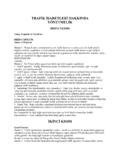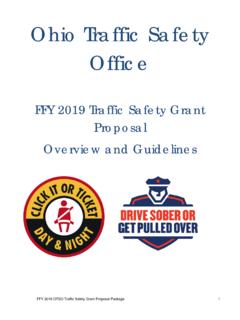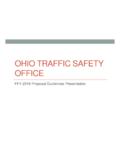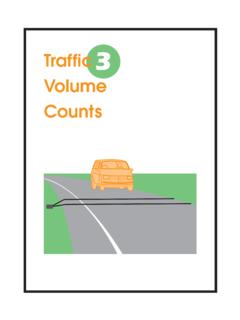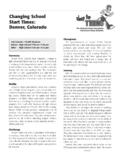Transcription of Principles for Selection of Intersection Type - KGM
1 DDrraafftt 22000000--0022--1155 traffic safety Strategy Highway Design Principles for Selection of Intersection Type February 2000 2000-02-10 Principles for Selection of Intersection Type List of Contents Page 1 Introduction 1 Purpose 1 Definitions 1 Contents 1 2 Proposed Selection model 2 Model overview 2 Step I. Applicability of at-grade Intersection 4 Step II a. Applicability of priority Intersection 5 Step II b. Acceptance of control Intersection 6 Step III a. Selection of priority Intersection type 7 Step III b.
2 Selection of control Intersection type 7 3 Examples 9 Example 1. 3-way Intersection 9 4 Continued Work 11 Revision of the proposed Selection model 11 Adaptation to Turkish conditions 11 SweRoad Ankara traffic safety PROJECT traffic safety Consultantcy Service Highway Design 1/11 DDrraafftt 22000000--0022--1155 1 Introduction Purpose The purpose with this report is to describe a model for Selection of Intersection type propose measures to adapt the model to Turkish conditions The objective should be to eventually incorporate a model for Selection of Intersection type into new comprehensive
3 Turkish design guidelines. To work out new design guidelines is however a long procedure. Awaiting new guidelines it is suggested that the proposed model is adapted to Turkish conditions. This should mainly be done by establishing preliminary Selection criteria for each step and a set of type intersections for each Intersection category. Definitions At-grade intersections can be classified into two main categories depending on if the main road traffic is controlled or not. Priority Intersection At-grade Intersection with priority for the main road traffic and control of secondary road traffic only.
4 Priority intersections can be divided into different types depending on Control Intersection At-grade Intersection with control of the main road traffic as well as secondary road traffic . There are two types of control intersections: signalized Intersection and roundabouts Contents Generally the Selection of Intersection type should be made from a socioeconomic point of view where construction costs, accident costs, environmental costs and travel time costs are considered. However, for some cases the Selection can be based on experiences from other similar intersections.
5 Thus it is not always necessary to make a socioeconomic calculation considering all possible types of intersections. The traffic safety aspect is suggested to be the primary criteria. Thus the safety should first be checked to meet the requirements. Other effects should then be checked to be acceptable. In this report the following is presented: Proposal for a procedure for the Selection of at-grade Intersection type Examples based on Swedish Selection criteria Suggestions for continued work to revise the model and to adapt it to Turkish conditions SweRoad Ankara traffic safety PROJECT traffic safety Consultantcy Service Highway Design 2/11 DDrraafftt 22000000--0022--1155 2 Proposed Selection model Model overview General description The model is divided into three steps with a number of Selection criteria.
6 The criteria are based on road and traffic conditions concerning type of road, location and traffic , standard requirements concerning safety , speed and delays and experiences of safety and capacity performances of different Intersection types . The model is based on the following assumptions concerning different types of at-grade intersections: The traffic volumes may be too high to be operated by an at-grade Intersection and for certain road national motorways at-grade intersections are not accepted. Priority intersections are safe and give sufficient capacity for certain traffic volumes and speed limits.
7 If a priority Intersection is not sufficient for safety and capacity the main road traffic must also be controlled. This might not be accepted. Depending on location, traffic conditions and speed limits different types of priority or control Intersection should be selected. The Selection model shows a suggested procedure illustrated with Selection criteria based mainly on Swedish experiences of intersections on 2-lane roads. The Selection model must to be useful in Turkey be completed with Selection criteria based on Turkish Intersection types and accident and capacity data.
8 Required data Road and traffic conditions Road classification and location The acceptability of at-grade intersections and/or traffic control measures (stop or yield control) should be related to the road function. For some important roads at-grade intersections or traffic control measures might not be accepted in some cases. The acceptability of at-grade intersections and/or traffic control measures should also be depending on whether the road is located in a rural, sub-urban or urban area. traffic conditions traffic data is needed mainly on daily traffic volumes on the primary and secondary road.
9 For detailed capacity control and design traffic data is also needed on hourly traffic and turning traffic . The traffic growth during the expected service life of the planned Intersection must be considered. The service life varies depending on type of project. For small projects in urban areas it should be shorter than for large projects in rural areas. The official project life for state roads in Turkey is 20 years. Standard requirements safety safety is suggested to be the primary Selection criterion.
10 The basic safety requirements for intersections, defined as the accepted number of expected accidents or injured, must therefore be established. SweRoad Ankara traffic safety PROJECT traffic safety Consultantcy Service Highway Design 3/11 DDrraafftt 22000000--0022--1155 Speed Both the safety level and the capacity of different Intersection types are depending on the speed limit on the primary road. The speed limit for the main road must thus be decided. The requirements for speed can be based on road classification and location.






